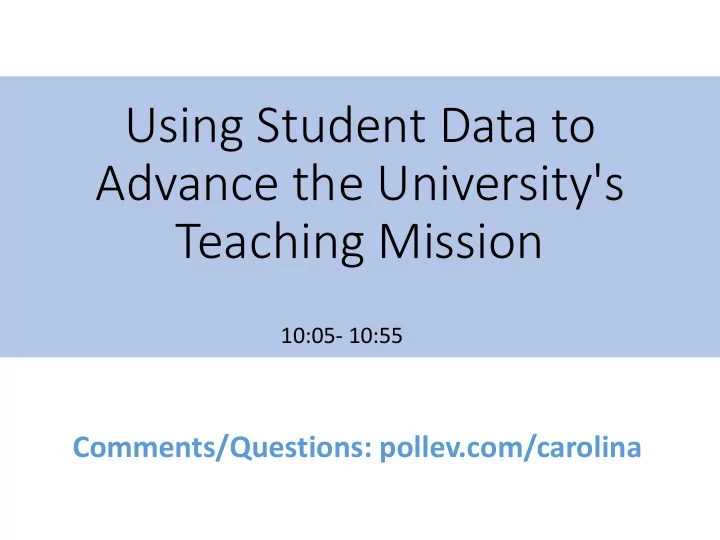

Using Student Data to Advance the University's Teaching Mission 10:05- 10:55 Comments/Questions: pollev.com/carolina
Using data t to track ck s student o outcomes: a a case s study in transitioning t to h high s struct cture a act ctive learning STEM cl classes KEVIN GUSKIEWICZ Dean of the College of Arts and Sciences KELLY HOGAN Associate Dean of Instructional Innovation Teaching Associate Professor of Biology
4 DEPARTMENTS (BIOLOGY, CHEMISTRY, PHYSICS and MATH) 12 GATEWAY COURSES TRANSFORMED 25 FACULTY APPRENTICES IN SIX SEMESTERS 45 FACULTY IN LEARNING COMMUNITIES >6,000 STUDENTS PER YEAR Improved Learning…
New tools needed LISTENING TO CONTENT PRACTICE AND FEEDBACK
Stages of Use a new innovation Innovation Process: Decide to try the innovation Convinced of value of innovation Learn about innovation “WHAT BARRIERS EXIST?” TIME TO DEVELOP THE COURSE . KNOWLEDGE ABOUT PEDAGOGY SUPPORT FROM A GROUP OF COLLEAGUES
INTERVENTION: 1. MENTOR-APPRENTICE 2. FACULTY LEARNING RELATIONSHIPS COMMUNITIES SUPPORT FROM TIME (COURSE RELEASE) COLLEAGUES DURING KNOWLEDGE/PRACTICE WITH CULTURAL SHIFT PEDAGOGY
DESIRED OUTCOME FOR PEDAGOGY: High Structure Active Learning After class During problem sets, online quizzes class Before problem solving, individual work, class peer instruction, polling/clickers, designing Readings, videos, experiments, etc online homework, online discussions
CHEMISTRY: EVIDENCE THAT INCREASING STRUCTURE IMPROVES PERFORMANCE FOR ALL Additionally, D/F rates dropped from 18% to 9.5% for all students Organic Chemistry I. Nearly identical final exams given. M.T. Crimmins and B. Mdkiff J. Chem. Educ. , 2017, 94 (4), pp 429–438
PHYSICS: Increasing structure improves learning of specific concepts Lecture/Studio with Life Science Focus Traditional structure + Some Active Learning Traditional structure D.P. Smith et al. American Journal of Physics 86 , 862 (2018)
PHOTO CREDIT: KRISTEN CHAVEZ Preliminary f findings acr cross p project ct: 13 13 % increase in normalized learning gains with high structure, active learning compared to instructor centered design (data from over 14,000 student measurements)
PHOTO CREDIT: KRISTEN CHAVEZ Have the pedagogical/curricular changes impacted different student groups?
Biology: Some student groups disproportionately benefit from increased structure 6.3 % increase 6.1 % increase First generation students 3.2 - 3.7 % increase Black students Failure rates dropped by 40%. All students Eddy, S. L.; Hogan, K. A. CBE Life Sci. Ed. 2014 , 13 , 453-468
Those results required obtaining data from institutional data requests… What if we all had a way to see data for our own classes routinely?
Change in Grade Distribution for First Generation, Pell-Eligible Students in One Redesigned Course (Biol 202) A B C D F W 60 77% successful 50 82 % successful percent of students 40 30 20 10 0 Fall 2012 Fall 2016 Data retrieved n=22 n=27 from MCAD
My Course Analytics Data (MCAD) Data are available from Fall 2010 to the most recent semester during which the course was taught and completed. Example data from the dashboard show the percent of students in different demographic categories. Hovering over the bars will give the percentages and total number in each subgroup. Learn more: https://cfe.unc.edu/mcad/
My Course Analytics Data (MCAD) Example data. Dashboard users customize their queries to examine individual courses in specific semesters or to combine multiple semesters. Pell A B C D recipient A Non-Pell D B C recipient
MARC COHEN ASSISTANT A PROFESSOR’S PROFESSOR PERSPECTIVE ENGLISH AND COMPARATIVE LITERATURE
C A B Underrepresented minority A B Non- Underrepresented minority
B Female C A B Male
A C First B generation Non-First A B generation
MCAD IN THE PATRICK CONWAY CLASSROOM – AND IN CFE WORKSHOP THE CHAIR’S OFFICE 2 NOVEMBER 2018
PEDAGOGICAL PRINCIPLE Students come to the classroom with preconceptions about how the world works. If their initial understanding is not engaged, they may fail to grasp the new concepts and information that are taught. National Research Council: How People Learn. Washington, DC: National Academy Press, 2000, pp 14-15
MCAD’S ROLE • In large classes, difficult to identify those individual preconceptions. • One partial solution: • Look to the success of various groups in previous years, and • Adjust the class content to reach those with less success in those years.
EXAMPLE: WOMEN IN ECONOMICS • A national trend: fewer women majoring in Economics • 2013: look “by hand” at grades I gave in Econ 101. Women seemed to have somewhat lower grades on average. • Response: • Changing examples and applications – more music/design/advertising. • Identifying/highlighting successful women in economics. • Greater emphasis on engaging women in the classroom. • By 2015: closer to parity. • Today: with MCAD, such queries are done in seconds.
PROBLEMS • Loose link between pedagogical goal and available categories. • Only available for completed courses. “Formative assessment” would be very helpful.
FROM THE CHAIR’S PERSPECTIVE • NB: Chairs don’t have access to other faculty’s data at present. • In courses where we have challenges – differing success rates – we can quantify these differences. • Over time, we can experiment with teaching techniques as a department to bring success rates in line with our high expectations for our students. • Example: Eddy, Sarah L., and Kelly A. Hogan. 2014. “Getting Under the Hood: How and for Whom Does Increasing Course Structure Work?” CBE-Life Sciences Education 13 (3): 453–68.
Discussion “rules”. We invite you to join into the conversation in multiple ways: Raise your hand. (Please limit your comments to 60 seconds or less, so that many people have an opportunity to join the conversation.) Write on a notecard and signal to the moderator for pick up. Use pollev.com/carolina for anonymous questions/comments.
Recommend
More recommend